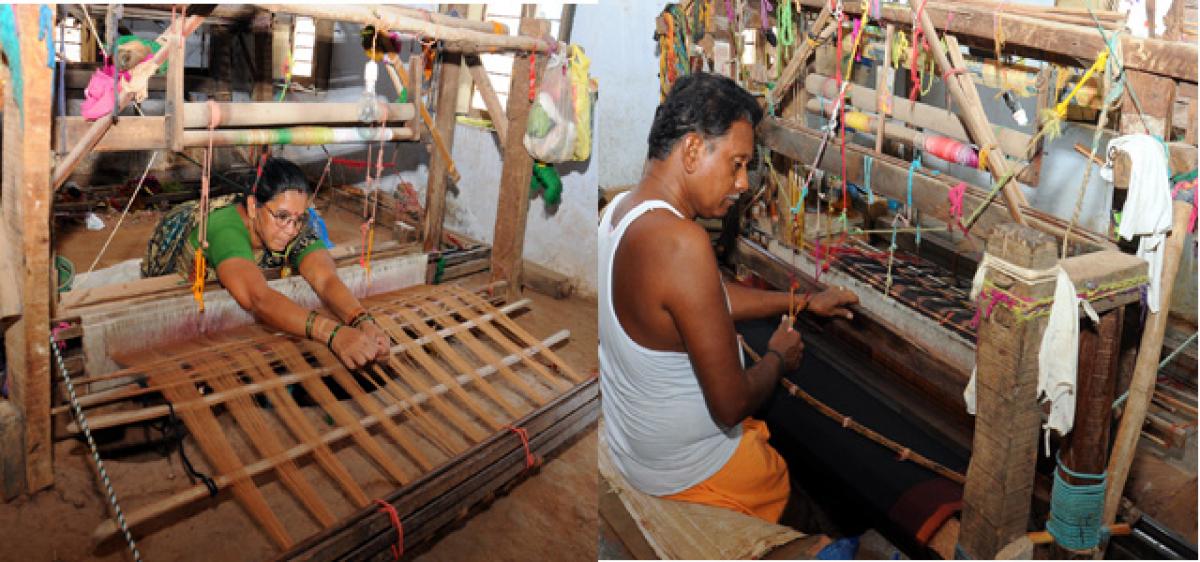Live
- Fishery activities get a big boost in TDP budget
- Today’s welfare measures aim to empower: Nirmala Sitharaman
- Six scholars, including two women, win Infosys Prize 2024
- Gurukula zonal level sports meet concludes
- Vagdevi Jr College student selected for national basketball tourney
- Maoist area committee member arrested
- Collectorate staff protest attack on DC
- Villagers urge authorities to continue launch service even after construction of bridge
- MLA Padmavathi launches free lunch for readers
- Police high-handedness sparks outrage in Kodangal
Just In

Mangalagiri (Guntur): The famed handloom cotton silk fabrics associated with the name of this tiny municipal town, a gateway to the state capital, fades into oblivion and the passersby miss the sounds produced by looms sooner or later, thanks to the dwindling hands.
Mangalagiri (Guntur): The famed handloom cotton silk fabrics associated with the name of this tiny municipal town, a gateway to the state capital, fades into oblivion and the passersby miss the sounds produced by looms sooner or later, thanks to the dwindling hands.
A visit by The Hans Team close on the heels of the Jana Sena chief Pawan Kalyan’s ‘Chenetha Garjana’ held at a sprawling ground, a stone’s throw from Mangalagiri, unfolded the tale of vanishing handloom industry.
Young generation is averse to pick up the profession handed down from forefathers as it looks no longer attractive and promising when only the aged stick to the looms.
As a result, the number of looms fell to 400-600 from 10,000 some three decades ago for want of workers. Besides, power looms too cast a spell of disaster on handloom industry.
Take the case sexagenarian P Veeranandam, who has been weaving on looms for four decades.
He has suffering with eye disorder, joint pains and asthma associated with his vocation and has been languishing with little support from the government in the form of ESI facility when his children chose to abandon the profession which he continued with a passion for a long time.
Ch Maheshwar Rao, a worker, said the artisan profession is on the deathbed as the hapless workers end up with poor wages at the end of the day. If a whole family of four members engaged in weaving a 25 metre cloth(four sarees) by taking one full week, it will get only a paltry sum of Rs 1,500.
It means Rs 200-250 per head per week. “Who will depend on this profession with such poor wages when even farm workers are receiving Rs 200-300 a day”, asks Maheswara Rao.
Summing it up, P Balakrishna, state general secretary of AP handloom workers union, said there is little support from the government in terms of procuring handloom-woven dress materials.
The government should come to the rescue of the ailing industry by way of procuring school uniforms made on handlooms. Sadly, it did not happen.
Instead, the power loom-made uniforms are purchased and shown as those produced on handlooms, he complained. As the dress material made on power looms is relatively cheaper when compared to the hand-made product which obviously means huge gains for the official agencies entrusted with procurement of school uniforms, he alleged.
Even though, Mangalagiri brand of cotton sarees and other fabrics got a huge market potential. West Bengal Chief Minister Mamata Benerjee is a regular customer for the last two years and very much fond of seeing herself in Mangalagiri cotton sarees.
The demand for Mangalagiri cotton sarees has been on the rise, courtesy the film industry. A mammoth 3,000 metres of cotton cloth woven on the local looms was purchased for Bahubali movie. “It is all good to hear.
But the profits will go to only master weavers and big traders, leaving poor workers starved”, says Maheswara rao.
There is a restriction imposed by Centre that 11 varieties of cloth should be manufactured by only handloom weavers which included sarees, dhotis, towels etc. But the safeguards have been thrown to the winds, thanks to the all-powerful power loom lobbies.
Balakrishna urged the government to establish Handloom Parks in the state and strengthen the co-operative societies so as to sustain handloom industry.

© 2024 Hyderabad Media House Limited/The Hans India. All rights reserved. Powered by hocalwire.com







